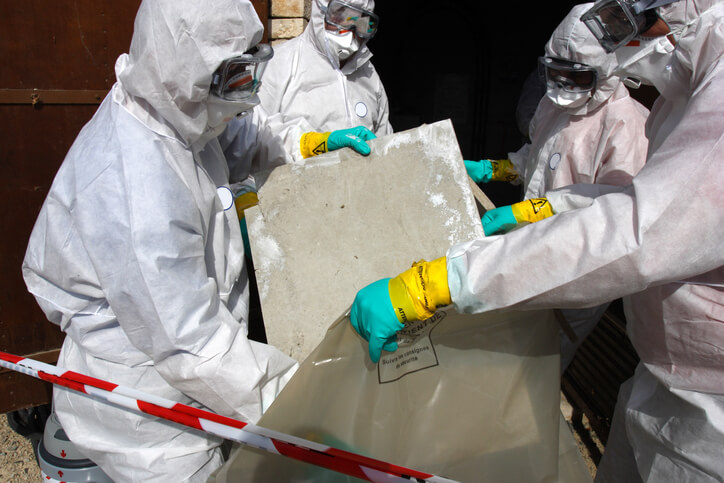Get Your Free Mesothelioma Guide

Find a Top Mesothelioma Doctor

Access Help Paying for Treatment

The best way to handle and dispose of asbestos is to hire licensed asbestos abatement professionals. Only professionals should test, remove and dispose of asbestos-containing materials. Companies are working to reduce the costs of asbestos recycling methods.

Asbestos-containing materials are dangerous if not handled properly. They can put workers and the public at risk. Asbestos exposure causes diseases such as mesothelioma cancer, lung cancer and asbestosis.
The risk of developing one of these diseases increases with every exposure to asbestos. Sadly, mesothelioma specialists haven’t found a cure. Asbestos-related diseases are treatable but incurable. That’s why strict regulations exist.
These regulations aim to prevent workers and the general public from exposure to asbestos. Large fines and serious penalties are in place for those who violate asbestos laws.
Fines and penalties deter do-it-yourselfers from performing asbestos abatement projects. These projects should be carried out by a professional. They also incentivize building owners and abatement companies to follow the rules.

The most important thing to know about asbestos is that you should not handle it. Asbestos is a deadly carcinogen. Only licensed professionals should handle and dispose of it.
While you can find information online about how to do asbestos abatement, don’t attempt it. Do not disturb asbestos-containing materials in any way.
If you find any asbestos products in your home, ensure they don’t release fibers. To do this, gently spray them with water until a professional can look at them and give advice.
These professionals receive training and certification to follow all federal and state laws. If you don’t hire a professional, you are likely to break asbestos laws. You also run the risk of facing a serious fine or penalty.
Handling and disposing of asbestos regulations include:
If you find any asbestos products in your home, ensure they don’t release fibers. To do this, gently spray them with water until a professional can inspect them and give advice.
These professionals receive training and certification to follow all federal and state laws. If you don’t hire a professional, you are likely to break asbestos laws. You also run the risk of facing a serious fine or penalty.
It’s now possible to turn asbestos products into non-toxic materials, like glass or porcelain. This process involves heating the substance with microwave thermal treatments or milling it at high speed. This technology has been developed by private companies and the U.S. Department of Energy. It can be quite complicated and costly.
Several methods exist for recycling asbestos:
The non-hazardous end products of these recycling methods may be sent to a regular landfill. Or they can be used in construction materials, as packing material or as concrete aggregate.
Some methods reduce asbestos waste by 50% to 99.7%, depending on the product being recycled. A smaller volume is better for landfills. It reduces the cost of dumping asbestos because disposal pricing is based on volume.
Recycling asbestos now costs about three times as much as disposal. Some of the cost may be recouped by selling the nonhazardous end products.
In the U.S., asbestos recycling is not available to the general public. The Department of Defense has recycled asbestos at the Savannah River Site in Aiken, South Carolina. Private companies are working on developing and refining asbestos recycling technologies. The goal is to make it more affordable in the near future.
Asbestos recycling is a safer way to dispose of asbestos materials. There are fewer regulated sites for waste disposal. This means asbestos recycling will soon become more important.
Get Your Free Mesothelioma Guide

Find a Top Mesothelioma Doctor

Access Help Paying for Treatment

Asbestos abatement projects must be done properly. There are serious penalties for failing to do so. These include heavy fines and possible jail time.
The U.S. Environmental Protection Agency requires certain practices for demolishing asbestos buildings. This protects workers and the public from asbestos. These practices involve creating a plan to safely remove the asbestos.
Preventing the release of asbestos particles and following disposal laws reduces disease incidence. Violating these rules may result in large fines and penalties.
Asbestos products may be common in homes and schools. Knowing about them can help you protect your family from exposure. It will also help your family recognize and avoid improperly dumped waste that may contain asbestos.
Older asbestos-containing products can include:
There is no way to visually know if a product contains asbestos. The best practice is to learn which products might have asbestos. Treat them as if they do until you test them.
When people rent or purchase a new home that was constructed before the 1990s, it is likely to contain asbestos products. Even new homes may contain asbestos. Roofing and flooring, cement shingles, millboard and corrugated sheets may have it.
If you rent and believe improper asbestos abatement has taken place, you have a right to report it. Contact the EPA and and your county and/or state’s department of environmental quality. Report workplace violations to the Occupational Safety and Health Administration.
It’s important to report suspected violations because it keeps possible asbestos fibers from contaminating the environment. It also prevents people from accidentally handling the materials.
The following federal laws and government agencies are responsible for establishing regulations involving the handling and disposal of asbestos.
Two primary government agencies handle asbestos regulations.
Check national and local government websites. Also, check university and institutional guides. They have resources on how to handle and dispose of asbestos. These include the EPA and OSHA.
You can review the following resources on handling and disposing of asbestos to learn more:
Your web browser is no longer supported by Microsoft. Update your browser for more security, speed and compatibility.
If you are looking for mesothelioma support, please contact our Patient Advocates at (855) 404-4592
The Mesothelioma Center at Asbestos.com has provided patients and their loved ones the most updated and reliable information on mesothelioma and asbestos exposure since 2006.
Our team of Patient Advocates includes a medical doctor, a registered nurse, health services administrators, veterans, VA-accredited Claims Agents, an oncology patient navigator and hospice care expert. Their combined expertise means we help any mesothelioma patient or loved one through every step of their cancer journey.
More than 30 contributors, including mesothelioma doctors, survivors, health care professionals and other experts, have peer-reviewed our website and written unique research-driven articles to ensure you get the highest-quality medical and health information.
My family has only the highest compliment for the assistance and support that we received from The Mesothelioma Center. This is a staff of compassionate and knowledgeable individuals who respect what your family is experiencing and who go the extra mile to make an unfortunate diagnosis less stressful. Information and assistance were provided by The Mesothelioma Center at no cost to our family.LashawnMesothelioma patient’s daughter


King, D. (2024, November 18). Guide to Handling, Disposing and Recycling Asbestos. Asbestos.com. Retrieved April 17, 2025, from https://www.asbestos.com/exposure/handling-disposing-asbestos/
King, Daniel. "Guide to Handling, Disposing and Recycling Asbestos." Asbestos.com, 18 Nov 2024, https://www.asbestos.com/exposure/handling-disposing-asbestos/.
King, Daniel. "Guide to Handling, Disposing and Recycling Asbestos." Asbestos.com. Last modified November 18, 2024. https://www.asbestos.com/exposure/handling-disposing-asbestos/.
